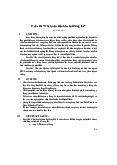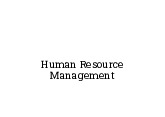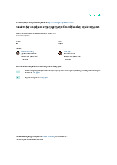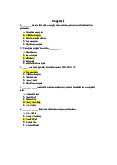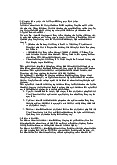










Preview text:
CHAP 1 INTRO TO HRM
1. In order to enable an organization to compete in the 21st century, human resource management
needs to focus on - Developing a skillful and flexible workforce
2. Below are the main activities of the HR Department EXCEPT - Directing operations manager
3. The key to quality product and services for an organization depends on how it manages - Employees
4. The HR owned by an organization can be used to compete if the resource is - Well managed
5. Which of these is NOT one of the main technological effects towards human resource management?
- Technology has eliminated supervising roles in employee management
6. Which of the following is NOT considered one of the line supervisor's responsibilities for effective
human resources management under the general headings outlined by a major company discussed in the textbook?
- Changing employees' attitudes regarding work
7. A line manager's human resource responsibilities most likely include all of the following EXCEPT
- Marketing new products and services
8. Which of the following refers to the authority a manager has to advise other managers or employees? - Staff authority
CHAP 2. Talent Management & Job Analysis
1. Which term refers to a procedure for determining the duties and skill requirements for a specific
job and the kind of person most suitable for a position? - Job analysis
2. The information resulting from a job analysis is primarily used for writing - Job descriptions
3. During a job analysis, a human resources specialist will most likely collect information about all of the following EXCEPT - Employee benefits options
4. Job analysis is most important because managers use it to - Support all HRM activities
5. Maria, an HR manager at ATX Manufacturing, needs to know what sorts of people to recruit for a
process engineering job at the firm. Which of the following would be most useful for Maria's task? - job analysis
6. What is the first step in conducting a job analysis?
- deciding what information to collect
7. Which of the following would LEAST likely involve the use of job analysis information? - diversification oversight
8. Anna, a new employee at Concord Electronics, wants to make sure she understands who to report
to at the firm and the title of various positions. Which of the following would most likely help Anna? - organization chart
9. Anita, an HR manager, is in the process of conducting a job analysis. She has just finished selecting
a sample of representative positions. What should Anita do next?
- interview employees to gather information about the job's duties and responsibilities
10. What is the final step of the job analysis process? - writing a job description
CHAP 3. Personnel Planning and Recruiting
1. ________ is the process of deciding what positions the firm will have to fill and how to fill them. - Personnel planning
2. What is the purpose of recruiting? - developing an applicant pool
3. Steve, an HR manager for IBM, must decide what positions the firm should fill in the next 6
months, which means Steve is currently working on - workforce planning
4. A firm's ________ should guide employment planning and determine the types of skills and
competencies the firm needs. - strategic plan
5. Which of the following is LEAST likely to be considered by employers during the process of workforce planning? - organizational culture
6. Which of the following refers to studying variations in a firm's past employment levels to predict future needs? - trend analysis
7. The process of making forecasts based on the relationship between some causal factor like sales
volume and the number of employees required is called - ratio analysis
8. Newton Building Supplies hopes to generate an extra $4 million in sales next year. A salesperson
traditionally generates $800,000 in sales each year. Using ratio analysis, how many new salespeople should Newton hire? - 5 (4MIL/800K)
9. A ________ shows graphically how two variables are related. - scatter plot
10. ____ contain data on employees' performance records, educational backgrounds, and promotion recommendations
- Qualifications inventories (ki m k ể ê trình đ ) ộ
11. What is the primary goal of the recruitment and selection process?
- hiring the best candidates for positions
12. Theresa, an HR manager, works for a firm that is planning to expand overseas. Theresa is in the
process of workforce planning and has already forecasted the firm's labor demand. What should Theresa do next?
- identify labor supply-demand gaps CHAP 4. Selecting Employees
1. Hiring workers who have criminal backgrounds without proper safeguards is considered - negligent hiring
2. What is the primary goal of employee selection? - achieving person-job fit
3. As a manager, what is the most important reason to select employees carefully?
- improve personal and organizational performance
4. Effective employee screening will most likely
- reduce dysfunctional workplace behaviors
5. If a person scores a 70 on an intelligence test on one day and scores 110 when retested on
another day, you might conclude that this test is - unreliable
6. If a person scores a 78 on a test on one day and scores a 79 when retested on another day, you
would most likely conclude that the test is - reliable
7. Which assessment method has a high development cost? - structured interviews
8. What is the purpose of recruiting?
- developing an applicant pool
9. What type of screening device is designed to measure attitudes regarding tolerance of others who steal?
- paper-and-pencil honesty tests
10. All of the following are guidelines for conducting an effective interview EXCEPT
- asking the candidate questions that require yes or no answers
11. Which of the following is the most likely outcome of using the same questions with all
candidates being interviewed? - reducing bias
12. Which question below is an example of a background question?
- "What experience and training have you had with drafting designs for commercial buildings?"
CHAP 5. Training and Development
1. ____ provides new employees with the basic background information required to perform their jobs satisfactorily - Employee orientation
2. Which of the following would perform the initial orientation in most firms? - HR specialist
3. Maria was recently hired as an accountant with a large marketing firm. Today is Maria's first day of
work, and she will be attending an employee orientation session. Which of the following is LEAST
likely to be addressed during Maria's orientation? - sales methods
4. Which of the following is NOT one of the primary purposes of employee orientation? - The employee should with the firm's softw become skilled are.
5. What is an alternative term for employee orientation? - onboarding
6. Which of the following terms refers to the methods used to give new or present employees the
skills they need to perform their jobs? - training
7. Lucas, an HR manager, has been assigned the task of creating a training and development program
for his firm's employees. According to the ADDIE training process model, what is the first step that Lucas should take?
- conduct a needs analysis
8. Anna, an HR manager, wants to determine the training needs of a new employee in the shipping
department. Which of the following would most likely help Anna? - task analysis
9. In the ADDIE training process model, which of the following occurs immediately after a needs
analysis has been conducted?
- designing the overall training program
10. Which of the following would most likely occur during the implementation stage of a training program?
- providing on-the-job training to the targeted group of employees
11. A performance analys is is primarily used to assess the training needs of - current employees CHAP 6. Performance Appraisal
1. The process of evaluating an employee's current and/or past performance relative to his or her
performance standards is called - Performance appraisal
2. Which of the following is NOT one of the recommended guidelines for setting effective employee goals?
- administering consequences for poor performance
3. SMART goals are best described as
- Specific, Measurable, Attainable, Relevant, and Timely
4. All of the following are reasons for appraising an employee's performance EXCEPT
- creating an organizational strategy map
5. In most organizations, which of the following is primarily responsible for appraising an employee's performance? - Employee's peers
6. Which of the following is LEAST likely to be used by firms as an alternative source of performance appraisal information? - Outside experts
7. Setting work standards, assessing an employee's performance against those standards, and
providing employee feedback are the three steps of the - performance appraisal cycle
8. In order to be the most effective, the performance management process should occur - continuously
9. Which performance appraisal technique lists traits and a range of performance for each? - graphic rating scale
10. Which performance appraisal method involves distinguishing between the worst and best
employees based on a trait or traits? - alternation ranking
11. Suppose you have five employees to rate. You make a chart of all possible pairs of employees for
each trait being evaluated. Then, you indicate the better employee of the pair for each pair. Finally,
you add up the number of positives for each employee. In this case, you have used the ________
method of performance appraisal. - paired comparison
12. Which performance appraisal tool is being used by a supervisor who places predetermined
percentages of rates into various performance categories? - forced distribution
13. Which of the following is one of the primary complaints regarding the use of the forced
distribution method for performance appraisals? - harm to employee morale
14. Which performance appraisal tool involves a supervisor maintaining a log of positive and
negative examples of a subordinate's work-related behavior? - critical incident
15. At M&M Enterprises, subordinates rate supervisor performances anonymously. Which of the
following refers to the process used at M&M? - upward feedback
16. Which of the following terms refers to a performance appraisal based on surveys from peers,
supervisors, subordinates, and customers? - 360-degree feedback
CHAP 7. STRATEGIC PAY PLAN & INCENTIVE PLANS
1. Which of the following terms refers to any salary increase the firm awards to an individual
employee based on his or her individual performance? - Merit pay
2. How does merit pay differ from a bonus?
- Merit pay becomes part of an employee's base pay, but a bonus does not.
3. Which term refers to any plan that ties pay to productivity or profitability? - Variable pay
4. Workers at a t-shirt shop are paid a sum for each t-shirt they produce. Which incentive plan is
most likely used by the employer? - Piecework
5. What is the main benefit of paying salespeople a ?
combination of salary and commission
- Limiting the firm's risk of overly high commissions
6. According to research, most firms use ________ to motivate the short-term performance of managers. - Annual bonuses
7. Which of the following involves setting a production standard for a specific work group and then
paying incentives to the group members if they exceed the standard? - Team incentive plan
8. External equity refers to
- How a job's pay rate in one company compares to the job's pay rate in othercompanies
9. Internal equity refers to
- How fair the job's pay rate is when compared to other jobs within the samecompany
10. ____ refers to all forms of pay or rewards going to employees and arising from their employment. - Employee compensation
11. Lisa is an HR manager who has been assigned the task of establishing pay rates to ensure
external equity. What should Lisa most likely do first? - Conduct a salary survey
12. ____ is a formal and systematic comparison of jobs to determine the worth of one job relative to another. - Job evaluation
13. Which of the following is NOT one of the compensable factors emphasized in the Equal Pay Act? - Accountability
14. Plans in which a corporation contributes shares of its own stock to a trust established to
purchase shares of the firm's stocks for employees are known as
- Employee Stock Ownership Plans (ESOP)
15. A(n) ________ plan is an incentive plan that engages many or all employees in a common effort
to achieve a company's productivity objectives with any resulting cost-savings shared among employees and the company. - Gainsharing
CHAP 8. BENEFITS & SERVICES
(Benefit = pay without performance)
1. The primary purpose of ________ is to enable employees to balance work and family obligations. - work-life benefits
2. Which of the following provides services such as financial counseling, child care referrals, and adoption assistance?
- employee assistance program
3. Which condition must be met for an injured employee to receive workers' compensation benefits?
- The employee was injured while on the job.
4. Health insurance, life insurance, pensions, and child care assistance are best categorized as - benefits
5. Keith works as a construction foreman, and he is viewed as a reliable, competent employee. Keith
was recently injured in a car accident while on vacation, and his injuries are so severe that he will
not be able to return to work. Which of the following would most likely provide Keith with benefits?
- unemployment insurance
6. Which of the following terms refers to benefits for time not worked such as unemployment
insurance, vacation and holiday pay, and sick pay?
- supplemental pay benefits
7. The indirect financial and nonfinancial payments employees receive for continuing employment
with the company are called - benefits
8. Kim works a 4-day workweek that consists of 10-hour days. Kim's employer most likely offers - compressed workweeks
9. All of the following are Social Security benefits EXCEPT
- defined contribution benefits
10. Athena, a sales representative, was terminated from her position at Ross Manufacturing. On
Athena's last day of work, she was given a check for $5,000. What did Athena most likely receive from Ross Manufacturing? - severance pay
11. Elizabeth works at an auto firm, which recently shut down for five weeks to change machinery.
However, during the shutdown, Elizabeth was able to maintain her standard of living because of the firm's
- supplemental unemployment benefits
12. Which of the following benefits is required by federal or state law? - workers' compensation
CHAP 9. COLLECTIVE BARGAINING& EMPLOYMENT RELATIONS
1. What is the most likely result of unfair treatment and abusive supervision in the workplace? - increased stress
2. According to employee surveys, fair treatment in the workplace is exemplified by managers who - treat employees respectfully
3. Which activity involves establishing and maintaining positive employee-employer relationships? - employee relations
4. Why is employee involvement an effective employee relations strategy?
- shows employees that their opinions are valuable
5. All of the following are areas in which employees currently have legal rights EXCEPT - verbal abuse
6. The periodic administration of employee opinion surveys helps managers to - build two-way communication
